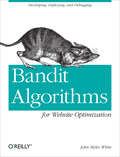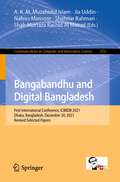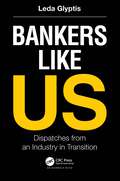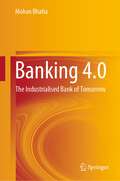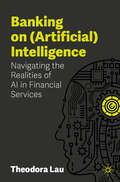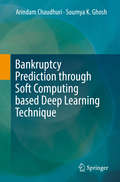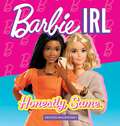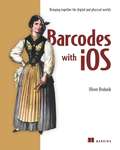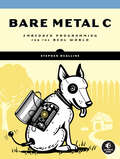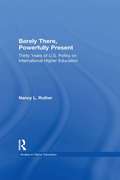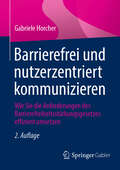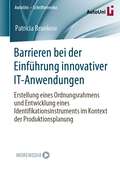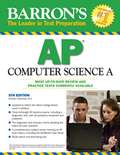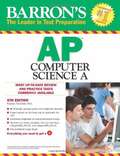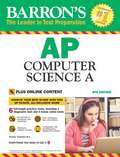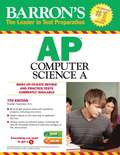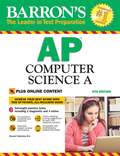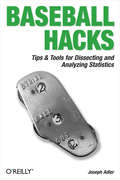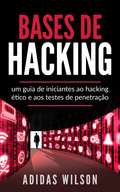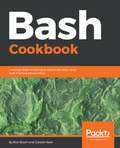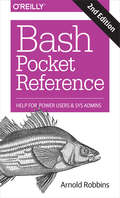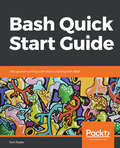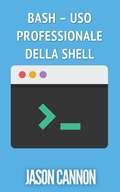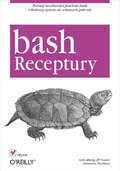- Table View
- List View
Bandit Algorithms for Website Optimization: Developing, Deploying, and Debugging
by John Myles WhiteWhen looking for ways to improve your website, how do you decide which changes to make? And which changes to keep? This concise book shows you how to use Multiarmed Bandit algorithms to measure the real-world value of any modifications you make to your site. Author John Myles White shows you how this powerful class of algorithms can help you boost website traffic, convert visitors to customers, and increase many other measures of success.This is the first developer-focused book on bandit algorithms, which were previously described only in research papers. You’ll quickly learn the benefits of several simple algorithms—including the epsilon-Greedy, Softmax, and Upper Confidence Bound (UCB) algorithms—by working through code examples written in Python, which you can easily adapt for deployment on your own website.Learn the basics of A/B testing—and recognize when it’s better to use bandit algorithmsDevelop a unit testing framework for debugging bandit algorithmsGet additional code examples written in Julia, Ruby, and JavaScript with supplemental online materials
Bangabandhu and Digital Bangladesh: First International Conference, ICBBDB 2021, Dhaka, Bangladesh, December 30, 2021, Revised Selected Papers (Communications in Computer and Information Science #1550)
by A. K. M. Muzahidul Islam Jia Uddin Nafees Mansoor Shahriar Rahman Shah Murtaza Rashid Al MasudThis book constitutes selected papers presented during the First International Conference on Bangabandhu and Digital Bangladesh, ICBBDB 2021, held in Dhaka, Bangladesh, in December 2021. Due to the COVID-19 pandemic the conference was partly held online. The 16 papers presented were thoroughly reviewed and selected from the 90 submissions. They present research in the areas of artificial intelligence, machine learning, image processing, blockchain technology, human-computer interaction, etc.
Bankers Like Us: Dispatches from an Industry in Transition
by Leda GlyptisThis book will resonate with anyone no matter where you reside on this journey, whether newbie or old guard. If you want to be part of this change, you need to understand all about the messy middle that Leda so expertly describes in this book. If you read this book and it doesn’t resonate, then I suggest you think about stepping aside. — Curt Queyrouze, President, Coastal Community Bank The world is going digital, and so is banking—in fits, starts, and circles. Why is it so hard? Why is the industry constantly getting in the way of its own technological progress and what can we do about it all? This book looks at the human and structural obstacles to innovation-driven transformation and at the change in habits, mindsets and leadership needed for the next stage of the digital journey and argues that this change will be brought about, not by external heroes and saviours, not by a generation yet to be born, but people just like us. People who understand the industry and its quirks. Bankers who have the grit, determination and energy to drive change. Bankers like us. This book celebrates and chronicles the shared experience of bankers like us. It starts with a ‘this is who we are’ piece, including the author’s trench credentials. It then presents an overview of corporate culture (this is what we deal with and a few ideas on how to handle it), as well as a piece on why transformation is so difficult and so many get it wrong; a piece on the challenges our lack of diversity brings or compounds, and a hopeful look-ahead on what a team of principled, dedicated folks can do despite everything.
Banking 4.0: The Industrialised Bank of Tomorrow
by Mohan BhatiaThis book shows banking professionals how to leverage the best practices in the industry to build a structured and coordinated approach towards the digitization of banking processes. It provides a roadmap and templates in order to industrialize the financial services firm over iterative cycles.To achieve the planned business and revenue results at the optimal costs, the digital transformation has to be calibrated and coordinated across both the front and back office, scaled and timed against external innovation benchmarks and Fintechs. To this end, data collection and evaluation must be ingrained, banking-specific artificial intelligence methods must be included, and all digitization approaches must be harmonized on an iterative basis with the experience gained. Spread over several chapters, this book provides a calibration and coordination framework for the delivery of the digital bank 4.0.
Banking on (Artificial) Intelligence: Navigating the Realities of AI in Financial Services
by Theodora LauThere is no lack of hype around artificial intelligence. We have only begun to scratch the surface of what this powerful technology can do. While tech and financial services become more intertwined, cutting through the noise has become more difficult but also more crucial. As a technology, AI is essential to advancing innovation, to creating efficiencies, and enhancing productivity while capturing opportunities by both incumbent financial institutions as well as fintechs. But it also comes with risks and potential for biases and disinformation, that can deepen inequalities and erode trust in our society. Responsible innovation must become part of our DNA and not as an afterthought. This book provides a tailored overview of what AI specifically means for financial services, a highly regulated yet also disrupted industry. It investigates the current state of AI applications in financial services today along with the state of funding and partnerships between tech and banking industries. It also examines the key pillars of responsible AI and the importance of keeping humans in the loop. The book takes a deep dive into the use cases in the financial services industry, the challenges and opportunities, and the fragmented regulatory landscape. How can we effectively assess risks, and balance innovation and customer centricity with trust in AI in financial services? Can smaller organizations reap the benefits of the technology? How can institutions deploy AI responsibly and securely, and promote a fairer and more equitable future for more people? While data is about bits and bytes, the realities of AI is very much human. This book will help spark dialogue and collaboration as we journey into the future.
Bankruptcy Prediction through Soft Computing based Deep Learning Technique
by Arindam Chaudhuri Soumya K. GhoshThis book proposes complex hierarchical deep architectures (HDA) for predicting bankruptcy, a topical issue for business and corporate institutions that in the past has been tackled using statistical, market-based and machine-intelligence prediction models. The HDA are formed through fuzzy rough tensor deep staking networks (FRTDSN) with structured, hierarchical rough Bayesian (HRB) models. FRTDSN is formalized through TDSN and fuzzy rough sets, and HRB is formed by incorporating probabilistic rough sets in structured hierarchical Bayesian model. Then FRTDSN is integrated with HRB to form the compound FRTDSN-HRB model. HRB enhances the prediction accuracy of FRTDSN-HRB model. The experimental datasets are adopted from Korean construction companies and American and European non-financial companies, and the research presented focuses on the impact of choice of cut-off points, sampling procedures and business cycle on the accuracy of bankruptcy prediction models. The book also highlights the fact that misclassification can result in erroneous predictions leading to prohibitive costs to investors and the economy, and shows that choice of cut-off point and sampling procedures affect rankings of various models. It also suggests that empirical cut-off points estimated from training samples result in the lowest misclassification costs for all the models. The book confirms that FRTDSN-HRB achieves superior performance compared to other statistical and soft-computing models. The experimental results are given in terms of several important statistical parameters revolving different business cycles and sub-cycles for the datasets considered and are of immense benefit to researchers working in this area.
Barbie IRL (In Real Life): Honestly, Same.
by Kristen MulrooneyBarbie has never been more relatable than in this officially licensed laugh-out-loud book that pairs real-world thoughts with images from the mega-popular @barbiestyle Instagram.&“And then he said it&’s just a dog&’s birthday party.&”&“Dump him.&” Barbie isn&’t perfect—far from it. Honestly, she&’s just like us. Barbie has bad hair days. She's late to work (that oat latte had nothing to do with it). Nothing is fitting right. She&’s also thinking about brunch after yoga. And she&’s definitely so over having her job explained to her. Yet, Barbie can still find empowerment and strength through it all. For fans of books like Men to Avoid in Art and Life, Barbie IRL (In Real Life) pairs real-world thoughts and everyday problems with images from the popular and fashionable @barbiestyle Instagram. Beneath perfect Instagram posts and highlight reels, we all have our own insecurities and issues—and this hilarious take on Barbie by humorist Kristen Mulrooney is a much-needed reminder that even the most flawlessly presenting dolls have issues of their own. A perfect gift for any Barbie lover or fan of the Barbie film, this book is presented in a perfect pink package, and filled with over 70 images and captions, in addition to 10 tips from Barbie about confidence, workplace, style, travel, and more.
Barcodes with iOS: Bringing together the digital and physical worlds
by Oliver DrobnikSummaryBarcodes with iOS is the first and only book that comprehensively addresses barcode technology for the iOS developer. It offers an introduction to commonly used formats, such as ISBN and UPC codes, and provides real-world examples that teach you how to integrate code scanning and generation into your apps. This book consolidates information about applicable Apple frameworks in one place so you can quickly add native barcode support to your existing enterprise apps or start building new apps that help bring together the physical and digital worlds.Purchase of the print book includes a free eBook in PDF, Kindle, and ePub formats from Manning Publications.About the TechnologyBarcodes are a universal way to track and share information, appearing on everything from cereal boxes to shop windows. Starting with iOS 7, Apple has added native features for building apps that scan, display, and print barcodes, eliminating the need for third-party libraries.About the BookBarcodes with iOS teaches you how to effectively use barcodes in your iOS apps. You'll master Apple's new barcode frameworks while you explore real-world examples that integrate code scanning and generation and metadata retrieval into your apps. Along the way, you'll pick up numerous best practices for bringing together the physical and digital worlds.This book is written for readers with a working knowledge of Objective-C and iOS app development.What's InsideLearn about all barcode formats supported by iOSNative barcode scanning with AV FoundationUsing Core Image and BarCodeKit to produce a wide range of barcodesPrinting to sheets and labels with AirPrintRetrieving metadata for products with NSURLSession and NSURLProtocolHarnessing context information from Core Location and iBeaconsAbout the AuthorOliver Drobnik is an independent consultant specializing in custom iOS and Mac development.Table of ContentsBarcodes, iOS, and you 1Media capture with AV Foundation 18Scanning barcodes 48Passbook, Apple's digital wallet 70Generating barcodes 97Getting metadata for barcodes 133Putting barcodes in context 172AppendicesHistory of the UPC 205GTIN prefix ranges 212GS1-128 application identifiers 217
Bare Metal C: Embedded Programming for the Real World
by Stephen OuallineBare Metal C teaches you to program embedded systems with the C programming language. You&’ll learn how embedded programs interact with bare hardware directly, go behind the scenes with the compiler and linker, and learn C features that are important for programming regular computers.Bare Metal C will teach you how to program embedded devices with the C programming language. For embedded system programmers who want precise and complete control over the system they are using, this book pulls back the curtain on what the compiler is doing for you so that you can see all the details of what's happening with your program. The first part of the book teaches C basics with the aid of a low-cost, widely available bare metal system (the Nucleo Arm evaluation system), which gives you all the tools needed to perform basic embedded programming. As you progress through the book you&’ll learn how to integrate serial input/output (I/O) and interrupts into your programs. You&’ll also learn what the C compiler and linker do behind the scenes, so that you&’ll be better able to write more efficient programs that maximize limited memory. Finally, you&’ll learn how to use more complex, memory hungry C features like dynamic memory, file I/O, and floating-point numbers. Topic coverage includes:The basic program creation processSimple GPIO programming (blink an LED)Writing serial device driversThe C linker and preprocessorDecision and control statementsNumbers, arrays, pointers, strings, and complex data typesLocal variables and proceduresDynamic memoryFile and raw I/OFloating-point numbersModular programming
Barely There, Powerfully Present: Years of US Policy on International Higher Education (RoutledgeFalmer Studies in Higher Education)
by Nancy L. RutherFirst published in 2003. Routledge is an imprint of Taylor & Francis, an informa company.
Barrierefrei kommunizieren für Unternehmen: Wie Sie die Anforderungen des Barrierefreiheitsstärkungsgesetzes effizient umsetzen (essentials)
by Gabriele HorcherDieses essential zeigt, welche Bedeutung digitale Barrierefreiheit für die Unternehmenskommunikation hat und wie diese die Ansprache Verbrauchern verändern wird. Das ab dem 28. Juni 2025 geltende Barrierefreiheitsstärkungsgesetz (BFSG) wird zum Beschleuniger dieser Entwicklung, mit der sich künftig viele Unternehmen auseinandersetzen müssen. Die renommierte Kommunikationswissenschaftlerin Gabriele Horcher zeigt auf, wie die neuen gesetzlichen Anforderungen effizient umgesetzt werden können und wie künstliche Intelligenz dabei helfen kann. Darüber hinaus stellt sie Strategien für Berater und Dienstleister vor, die ihre Kunden optimal unterstützen wollen.Ein auf den Punkt geschriebenes Buch für Entscheidungsträger, Kommunikations-, Compliance- und E-Commerce-Verantwortliche, die alles Wichtige über die spezifischen Herausforderungen der digitalen Barrierefreiheit erfahren und von den neuen Chancen profitieren wollen.
Barrierefrei und nutzerzentriert kommunizieren: Wie Sie die Anforderungen des Barrierefreiheitsstärkungsgesetzes effizient umsetzen
by Gabriele HorcherAb Juni 2025 verpflichtet das Barrierefreiheitsstärkungsgesetz (BFSG) erstmals auch Unternehmen zur digitalen Barrierefreiheit. Dieses Buch zeigt, wie Organisationen die gesetzlichen Anforderungen nicht nur erfüllen, sondern daraus echte Wettbewerbsvorteile entwickeln können. Kommunikationswissenschaftlerin Gabriele Horcher verbindet regulatorisches Know-how mit strategischem Weitblick und technologischer Innovationskraft. Mit praxisnahen Checklisten, Roadmaps, Branchenbeispielen und KI-gestützten Lösungen bietet das Buch konkrete Hilfestellung für Produkthersteller, Dienstleister, Händler und digitale Leistungserbringer. Es macht deutlich: Digitale Teilhabe ist kein Mehraufwand, sondern ein Zukunftsthema – für mehr Reichweite, bessere Kommunikation und nachhaltigen Unternehmenserfolg.
Barrieren bei der Einführung innovativer IT-Anwendungen: Erstellung eines Ordnungsrahmens und Entwicklung eines Identifikationsinstruments im Kontext der Produktionsplanung (AutoUni – Schriftenreihe #172)
by Patricia BrunkowPatricia Brunkow gibt einen Überblick über relevante Barrieren bei der Einführung von IT-Anwendungen in Unternehmen und stellt zwei Instrumente zur Identifikation und Vermeidung von Barrieren vor. Die Ergebnisse dieser Arbeit bieten aufgrund der Datenerhebung in einem Automobilunternehmen besonders praxisnahe Erkenntnisse.
Barron's AP Computer Science A (5th Edition)
by Roselyn TeukolskyThis best-selling review manual has been thoroughly updated to reflect the College Board's elimination of the Level AB course and the updated Level A syllabus. The new edition presents three full-length AP practice exams for the Level A course. The first exam is a diagnostic test and contains charts detailing the topics for each question. All three model tests have questions answered and explained. Test takers will also find an extensive subject review including new sections on static variables, the List interface, Integer. MAX_VALUE, and Integer. MIN_VALUE. A section on two-dimensional arrays is included for the Level A exam.
Barron's AP Computer Science A (6th Edition)
by Roselyn TeukolskyThe updated test prep manual presents computer science test takers with-- Three full-length AP practice tests for the Level A course, including a diagnostic test Charts detailing the topics for each test question All test questions answered and explained Test takers will also find an extensive subject review including sections on static variables, the List interface, Integer. MAX_VALUE, and Integer. MIN_VALUE. The practice exams contain several new questions on two-dimensional arrays and also reflect the new free-response style used on the 2012 AP exam.
Barron's AP Computer Science A With Bonus Online Tests, 8th edition
by Roselyn TeukolskyThis best-selling guide from Barron's offers practical, proven test-taking strategies and preparation for the Advanced Placement test. This updated manual presents computer science test takers with:Three AP practice tests for the AP Computer Science A test, including a diagnostic testCharts detailing the scoring suggestions for each free-response questionAnswers and explanations for every test questionA subject review includes static variables, the List interface, enhanced for loops, the import statement, many questions on 2-dimensional arrays, and a detailed analysis of the binary search algorithm. The book reflects the fact that the ClassCastException and downcasting have been removed from the AP Java subset. The practice exams reflect the new free-response style used on recent AP exams.BONUS ONLINE PRACTICE TESTS: Students who purchase this book will also get FREE access to three additional full-length online AP Computer Science A tests with all questions answered and explained. These online exams can be easily accessed by smartphone, tablet, or computer.
Barron's AP Computer Science A: (Seventh Edition)
by Roselyn TeukolskyThis updated manual presents computer science test takers with-- Three AP practice tests for the Level A course, including a diagnostic test Charts detailing the topics for each test question All test questions answered and explained A subject review covers static variables, the List interface, Integer. MAX_VALUE, and Integer. MIN_VALUE. The practice exams contain several new questions on two-dimensional arrays and reflect the new free-response style used on the 2012 AP exam. An optional book with CD-ROM presents two more model AP exams with answers, explanations, automatic scoring for multiple-choice questions, and a scoring chart. BONUS ONLINE PRACTICE TEST: Students who purchase this book or package will also get FREE access to one additional full-length online AP Computer Science A test with all questions answered and explained.
Barron's AP Computer Science A: With Bonus Online Tests
by Roselyn TeukolskyBarron’s AP Computer Science A with Online Tests is aligned with the current exam curriculum and provides key practice and subject review. This edition reflects the removal of the ClassCastException and downcasting from the AP Java subset, and practice tests include the free-response style used on recent exams. <P><P>The content review includes static variables, the List interface, enhanced for loops, the import statement, many questions on 2-dimensional arrays, and a detailed analysis of the binary search algorithm. <P><P>Online Practice Tests: The three additional full-length online AP Computer Science A tests have all questions answered and explained. These online exams can be easily accessed by smartphone, tablet, or computer.
Baseball Hacks: Tips & Tools for Analyzing and Winning with Statistics
by Joseph AdlerBaseball Hacks isn't your typical baseball book--it's a book about how to watch, research, and understand baseball. It's an instruction manual for the free baseball databases. It's a cookbook for baseball research. Every part of this book is designed to teach baseball fans how to do something. In short, it's a how-to book--one that will increase your enjoyment and knowledge of the game. So much of the way baseball is played today hinges upon interpreting statistical data. Players are acquired based on their performance in statistical categories that ownership deems most important. Managers make in-game decisions based not on instincts, but on probability - how a particular batter might fare against left-handedpitching, for instance. The goal of this unique book is to show fans all the baseball-related stuff that they can do for free (or close to free). Just as open source projects have made great software freely available, collaborative projects such as Retrosheet and Baseball DataBank have made great data freely available. You can use these data sources to research your favorite players, win your fantasy league, or appreciate the game of baseball even more than you do now. Baseball Hacks shows how easy it is to get data, process it, and use it to truly understand baseball. The book lists a number of sources for current and historical baseball data, and explains how to load it into a database for analysis. It then introduces several powerful statistical tools for understanding data and forecasting results. For the uninitiated baseball fan, author Joseph Adler walks readers through the core statistical categories for hitters (batting average, on-base percentage, etc.), pitchers (earned run average, strikeout-to-walk ratio, etc.), and fielders (putouts, errors, etc.). He then extrapolates upon these numbers to examine more advanced data groups like career averages, team stats, season-by-season comparisons, and more. Whether you're a mathematician, scientist, or season-ticket holder to your favorite team, Baseball Hacks is sure to have something for you. Advance praise for Baseball Hacks: "Baseball Hacks is the best book ever written for understanding and practicing baseball analytics. A must-read for baseball professionals and enthusiasts alike."-- Ari Kaplan, database consultant to the Montreal Expos, San Diego Padres, and Baltimore Orioles"The game was born in the 19th century, but the passion for its analysis continues to grow into the 21st. In Baseball Hacks, Joe Adler not only demonstrates thatthe latest data-mining technologies have useful application to the study of baseball statistics, he also teaches the reader how to do the analysis himself, arming the dedicated baseball fan with tools to take his understanding of the game to a higher level."-- Mark E. Johnson, Ph.D., Founder, SportMetrika, Inc. and Baseball Analyst for the 2004 St. Louis Cardinals
Bases de Hacking: um guia de iniciantes ao hacking ético e aos testes de penetração
by Adidas WilsonOriginalmente, o termo “hacker” referia-se a um programador que tinha competências a nível de sistemas operativos e código de máquina. Nos nossos dias, é qualquer pessoa que incorra em atividades de hacking. Hacking é o ato de mudar as funcionalidades de um sistema de forma a atingir um objetivo que não está no propósito original do criador. A palavra “hacking” é normalmente percebida de forma negativa, especialmente por pessoas que não percebem o trabalho de um hacker ético. No mundo do hacking, os hackers éticos são boas pessoas. Qual o seu papel? Usam o seu vasto conhecimento de computadores para o bem em vez do mal. Procuram falhas de segurança nos sistemas da organizações e negócios para prevenir atores maliciosos de tomarem vantagem dos mesmos. Para alguém que adora o mundo da tecnologia e dos computadores, seria inteligente considerar uma carreira de hacking ético. Você é pago (quantia interessante) para quebrar os sistemas. Começar não será como ir dar um passeio ao parque – tal como qualquer outra carreira. No entanto, se for determinado, verá que irá conseguir uma carreira lucrativa. Quando decidir iniciar-se nesta jornada, terá de cultivar a paciência. O primeiro passo para muitas pessoas é normalmente obter um curso em ciências de computadores. Pode também obter uma certificação A+ (CompTIA) – tem de fazer e passar a dois exames diferentes. Para conseguir fazer o teste de qualificação, precisa de ter pelo menos 500 horas de experiência em computação prática. A experiência é requerida, e uma qualificação em CCNA ou Network+ para avançar na carreira.
Bash Cookbook: Leverage Bash scripting to automate daily tasks and improve productivity
by Ganesh Naik Ron BrashCreate simple to advanced shell scripts and enhance your system functionality with effective recipesKey FeaturesAutomate tedious and repetitive tasksCreate several novel applications ranging from a simple IRC logger to a Web ScraperManage your system efficiently by becoming a seasoned Bash userBook DescriptionIn Linux, one of the most commonly used and most powerful tools is the Bash shell. With its collection of engaging recipes, Bash Cookbook takes you through a series of exercises designed to teach you how to effectively use the Bash shell in order to create and execute your own scripts. The book starts by introducing you to the basics of using the Bash shell, also teaching you the fundamentals of generating any input from a command. With the help of a number of exercises, you will get to grips with the automation of daily tasks for sysadmins and power users. Once you have a hands-on understanding of the subject, you will move on to exploring more advanced projects that can solve real-world problems comprehensively on a Linux system. In addition to this, you will discover projects such as creating an application with a menu, beginning scripts on startup, parsing and displaying human-readable information, and executing remote commands with authentication using self-generated Secure Shell (SSH) keys.By the end of this book, you will have gained significant experience of solving real-world problems, from automating routine tasks to managing your systems and creating your own scripts.What you will learnUnderstand the basics of Bash shell scripting on a Linux systemGain working knowledge of how redirections and pipes interactRetrieve and parse input or output of any commandAutomate tasks such as data collection and creating and applying a patchCreate a script that acts like a program with different featuresCustomize your Bash shell and discover neat tricks to extend your programsCompile and install shell and log commands on your system's console using SyslogWho this book is forThe Bash Cookbook is for you if you are a power user or system administrator involved in writing Bash scripts in order to automate tasks. This book is also ideal if you are interested in learning how to automate complex daily tasks.
Bash Pocket Reference: Help for Power Users and Sys Admins
by Arnold RobbinsItâ??s simple: if you want to interact deeply with Mac OS X, Linux, and other Unix-like systems, you need to know how to work with the Bash shell. This concise little book puts all of the essential information about Bash right at your fingertips.Youâ??ll quickly find answers to the annoying questions that generally come up when youâ??re writing shell scripts: What characters do you need to quote? How do you get variable substitution to do exactly what you want? How do you use arrays? Updated for Bash version 4.4, this book has the answers to these and other problems in a format that makes browsing quick and easy.Topics include:Invoking the shellSyntaxFunctions and variablesArithmetic expressionsCommand historyProgrammable completionJob controlShell optionsCommand executionCoprocessesRestricted shellsBuilt-in commands
Bash Quick Start Guide: Get up and running with shell scripting with Bash
by Tom RyderLearn how to write shell script effectively with Bash, to quickly and easily write powerful scripts to manage processes, automate tasks, and to redirect and filter program input and output in useful and novel ways.Key FeaturesDemystify the Bash command lineWrite shell scripts safely and effectivelySpeed up and automate your daily workBook DescriptionBash and shell script programming is central to using Linux, but it has many peculiar properties that are hard to understand and unfamiliar to many programmers, with a lot of misleading and even risky information online. Bash Quick Start Guide tackles these problems head on, and shows you the best practices of shell script programming. This book teaches effective shell script programming with Bash, and is ideal for people who may have used its command line but never really learned it in depth. This book will show you how even simple programming constructs in the shell can speed up and automate any kind of daily command-line work.For people who need to use the command line regularly in their daily work, this book provides practical advice for using the command-line shell beyond merely typing or copy-pasting commands into the shell. Readers will learn techniques suitable for automating processes and controlling processes, on both servers and workstations, whether for single command lines or long and complex scripts. The book even includes information on configuring your own shell environment to suit your workflow, and provides a running start for interpreting Bash scripts written by others.What you will learnUnderstand where the Bash shell fits in the system administration and programming worldsUse the interactive Bash command line effectivelyGet to grips with the structure of a Bash command lineMaster pattern-matching and transforming text with BashFilter and redirect program input and outputWrite shell scripts safely and effectivelyWho this book is forPeople who use the command line on Unix and Linux servers already, but don't write primarily in Bash. This book is ideal for people who've been using a scripting language such as Python, JavaScript or PHP, and would like to understand and use Bash more effectively.
Bash – Uso Professionale Della Shell
by Eugenia Franzoni Jason CannonSe vi siete mai detti "C'è un modo migliore per fare questa cosa", allora continuate a leggere.Dato che ho usato la shell Bash per oltre 15 anni quasi tutti i giorni, ho accumulato diversi "trucchi" da linea di comando che mi hanno fatto risparmiare tempo e frustrazioni. "Bash - Uso professionale della shell" è una raccolta di 10 tecniche che potete utilizzare subito per aumentare la vostra efficienza sulla linea di comando.Ecco cosa imparerete leggendo "Bash - Uso professionale della shell": Suggerimento 1: Autocompletamento con Tab Suggerimento 2: Passare alla directory precedente Suggerimento 3: Riutilizzare l'ultimo elemento della linea di comando precedente Suggerimento 4: Eseguire di nuovo un comando che inizia con una data stringa Suggerimento 5: Sostituzione dei comandi Suggerimento 6: Usare un ciclo sulla linea di comando Suggerimento 7: Eseguire di nuovo il comando precedente con privilegi di root Suggerimento 8: Eseguire di nuovo il comando sostituendo una stringa Suggerimento 9: Riusare una parola sulla stessa linea di comando Suggerimento 10: Correggere errori di digitazione ed abbreviare i comandi lunghi con degli alias
Bash. Receptury
by Cameron Newham Carl Albing Jp VossenPoznaj mo?liwo?ci pow?oki bash i dostosuj system do w?asnych potrzeb Jak pisa? skrypty konwertuj?ce pliki w formacie DOS i Unix?Jak konfigurowa? interpreter bash, aby odpowiada? potrzebom i stylowi pracy u?ytkownika?Jak opracowa? bezpieczne skrypty pow?oki?Bash to jedna z najpopularniejszych pow?ok systemów uniksowych, umo?liwiaj?ca prac? interaktywn? i wsadow?. J?zyk basha pozwala na definiowanie aliasów i funkcji, a tak?e zawiera konstrukcje steruj?ce przep?ywem. Bash (tak jak wiele innych narz?dzi opisanych w tej ksi??ce) stworzono w ramach projektu GNU - wolno dost?pnego systemu operacyjnego. Sposób u?ywania pow?oki jest bardzo prosty, polega na wprowadzeniu polecenia zgodnie z regu?ami sk?adni. Nast?pnie zostaje ono zinterpretowane i wykonane przez system. Ksi??ka "bash. Receptury" zawiera opis pow?oki bash oraz prezentuje praktyczne przyk?ady rozwi?za? problemów spotykanych powszechnie podczas projektowania skryptów. W ka?dej chwili mo?esz si? do nich odwo?a?, dostosowuj?c system do w?asnych potrzeb. Podr?cznik obejmuje równie? opis zasad funkcjonowania interpretera - ich zastosowanie umo?liwia zwi?kszenie wydajno?ci pracy. Korzystaj?c z tej ksi??ki, dowiesz si?, jak pobiera? interpreter bash dla ró?nych systemów lub korzysta? z pow?oki bash bez jej pobierania; poznasz techniki automatyzacji zada? oraz rozwi?zania skryptowe odnosz?ce si? do operacji wej?cia-wyj?cia czy przetwarzania plików, a tak?e sposoby tworzenia programów i wykonywania zada? administracyjnych.Praca z pow?ok? bashStandardowy strumie? wej?ciowy Standardowy strumie? wyj?ciowyWykonywanie polece?Podstawy tworzenia skryptów - zmienne pow?okiLogika i arytmetyka pow?okiDodatkowe mechanizmy skryptowePrzetwarzanie informacji o dacie i czasie Skrypty usprawniaj?ce prac? u?ytkownikaInterpretacja danychBezpieczne skrypty pow?okiZadania administracyjne"bash. Receptury" - wszystko, czego potrzebujesz, aby zapewni? optymalne warunki pracy systemu!
